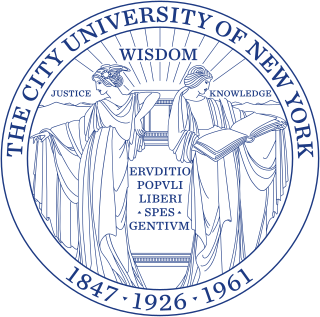
The City University of New York is the public university system of New York City. It is the largest urban university system in the United States, comprising 25 campuses: eleven senior colleges, seven community colleges, and seven professional institutions. In 1960, John R. Everett became the first chancellor of the Municipal College System of New York City, later known as the City University of New York (CUNY). CUNY, established by New York State legislation in 1961 and signed into law by Governor Nelson Rockefeller, was an amalgamation of existing institutions and a new graduate school.
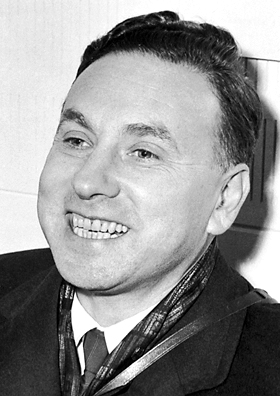
Robert Hofstadter was an American physicist. He was the joint winner of the 1961 Nobel Prize in Physics "for his pioneering studies of electron scattering in atomic nuclei and for his consequent discoveries concerning the structure of nucleons".

Charles Austin Beard was an American historian and professor, who wrote primarily during the first half of the 20th century. A history professor at Columbia University, Beard's influence is primarily due to his publications in the fields of history and political science. His works included a radical re-evaluation of the Founding Fathers of the United States, whom he believed to be more motivated by economics than by philosophical principles. Beard's most influential book, An Economic Interpretation of the Constitution of the United States (1913), has been the subject of great controversy ever since its publication. While it has been frequently criticized for its methodology and conclusions, it was responsible for a wide-ranging reinterpretation of early American history.

The Columbia University Graduate School of Journalism is located in Pulitzer Hall on the university's Morningside Heights campus in New York City. Founded in 1912 by Joseph Pulitzer, Columbia Journalism School is one of the oldest journalism schools in the world and the only journalism school in the Ivy League. It offers four graduate degree programs.
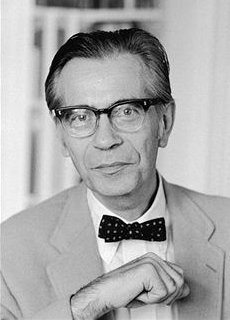
Richard Hofstadter was an American historian and public intellectual of the mid-20th century. Hofstadter was the DeWitt Clinton Professor of American History at Columbia University. Rejecting his earlier historical materialist approach to history, in the 1950s he came closer to the concept of "consensus history", and was epitomized by some of his admirers as the "iconic historian of postwar liberal consensus." Others see in his work an early critique of the one-dimensional society, as Hofstadter was equally critical of socialist and capitalist models of society, and bemoaned the "consensus" within the society as "bounded by the horizons of property and entrepreneurship", criticizing the "hegemonic liberal capitalist culture running throughout the course of American history".

Gotham: A History of New York City to 1898 is a non-fiction book by historians Edwin G. Burrows and Mike Wallace. Based on over twenty years of research, it was published in 1998 by Oxford University Press and won the 1999 Pulitzer Prize for History, and detailed the history of the city before the consolidation of the five boroughs in 1898. A follow-up volume, Greater Gotham: A History of New York City from 1898 to 1919, written by Wallace, was published in 2017 and covered New York City history for the following 20 years. Initial plans were to have the second volume's timeline go through World War II, but due to the amount of material, an upcoming third volume should cover the period from 1920 until 1945.

Mark Strand was a Canadian-born American poet, essayist and translator. He was appointed Poet Laureate Consultant in Poetry to the Library of Congress in 1990 and received the Wallace Stevens Award in 2004. Strand was a professor of English and Comparative Literature at Columbia University from 2005 until his death in 2014.

Vernon Louis Parrington was an American literary historian, scholar, and college football coach. His three-volume history of American letters, Main Currents in American Thought, won the Pulitzer Prize for History in 1928 and was one of the most influential books for American historians of its time. Parrington taught at the College of Emporia, the University of Oklahoma, and the University of Washington. He was also the head football coach at the College of Emporia from 1893 to 1896 and Oklahoma from 1897 to 1900. Parrington founded the American studies movement in 1927.
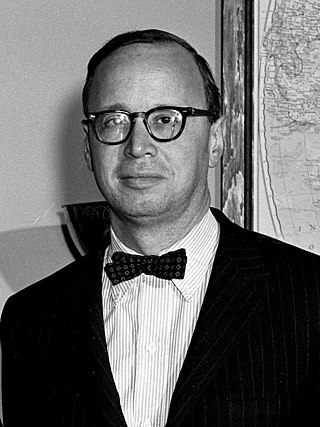
Arthur Meier Schlesinger Jr. was an American historian, social critic, and public intellectual. The son of the influential historian Arthur M. Schlesinger Sr. and a specialist in American history, much of Schlesinger's work explored the history of 20th-century American liberalism. In particular, his work focused on leaders such as Harry S. Truman, Franklin D. Roosevelt, John F. Kennedy, and Robert F. Kennedy. In the 1952 and 1956 presidential campaigns, he was a primary speechwriter and adviser to the Democratic presidential nominee, Adlai Stevenson II. Schlesinger served as special assistant and "court historian" to President Kennedy from 1961 to 1963. He wrote a detailed account of the Kennedy administration, from the 1960 presidential campaign to the president's state funeral, titled A Thousand Days: John F. Kennedy in the White House, which won the 1966 Pulitzer Prize for Biography or Autobiography.
Edwin G. "Ted" Burrows was a Distinguished Professor of History at Brooklyn College. He is the co-author of the Pulitzer Prize-winning Gotham: A History of New York City to 1898 (1998), and author of Forgotten Patriots: The Untold Story of American Prisoners During the Revolutionary War, (2008), which won the 2009 Fraunces Tavern Museum Book Award.

Eric Foner is an American historian. He writes extensively on American political history, the history of freedom, the early history of the Republican Party, African American biography, the American Civil War, Reconstruction, and historiography, and has been a member of the faculty at the Columbia University Department of History since 1982. He is the author of several popular textbooks. According to the Open Syllabus Project, Foner is the most frequently cited author on college syllabi for history courses. According to historian Timothy Snyder, Foner is the first to associate the storming of the Capitol on January 6, 2021 with section three of the Fourteenth Amendment to the Constitution.

William Shield McFeely was an American historian known for his Pulitzer Prize-winning 1981 biography of Ulysses S. Grant, as well as his contributions to a reevaluation of the Reconstruction era, and for advancing the field of African-American history. He retired as the Abraham Baldwin Professor of the Humanities emeritus at the University of Georgia in 1997, and was affiliated with Harvard University since 2006.
Robert A. Dallek is an American historian specializing in the presidents of the United States, including Franklin D. Roosevelt, John F. Kennedy, Lyndon B. Johnson, and Richard Nixon. He retired as a history professor at Boston University in 2004 and previously taught at Columbia University, the University of California, Los Angeles (UCLA), and Oxford University. He won the Bancroft Prize for his 1979 book Franklin D. Roosevelt and American Foreign Policy, 1932–1945 as well as other awards for scholarship and teaching.
Martin Bauml Duberman is an American historian, biographer, playwright, and gay rights activist. Duberman is Professor of History Emeritus at Lehman College in the Bronx, New York City.
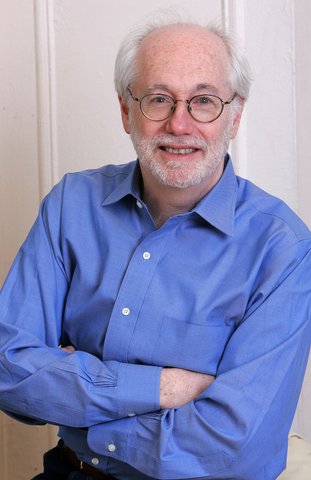
David Nasaw is an American author, biographer and historian who specializes in the cultural, social and business history of early 20th Century America. Nasaw is on the faculty of the Graduate Center of the City University of New York, where he is the Arthur M. Schlesinger Jr. Professor of History.
John Milton Cooper Jr. is an American historian, author, and educator. He specializes in late 19th and early 20th-century American political and diplomatic history with a particular focus on presidential history. His 2009 biography of Woodrow Wilson was a finalist for the Pulitzer Prize, and biographer Patricia O'Toole has called him "the world's greatest authority on Woodrow Wilson." Cooper is Professor Emeritus at the University of Wisconsin-Madison.
In the politics of the United States, the radical right is a political preference that leans towards ultraconservatism, white nationalism, white supremacy, or other far-right ideologies in a hierarchical structure which is paired with conspiratorial rhetoric alongside traditionalist and reactionary aspirations. The term was first used by social scientists in the 1950s regarding small groups such as the John Birch Society in the United States, and since then it has been applied to similar groups worldwide. The term "radical" was applied to the groups because they sought to make fundamental changes within institutions and remove persons and institutions that threatened their values or economic interests from political life.
Harold Coffin Syrett was an American historian. He served as the executive editor of The Papers of Alexander Hamilton and as the fourth president of Brooklyn College.
James Morrill Banner, Jr. is an American historian whose scholarly specialties are the history of the United States, of the discipline of history, and of historical thought. He has served in a number of different academic and public capacities.












